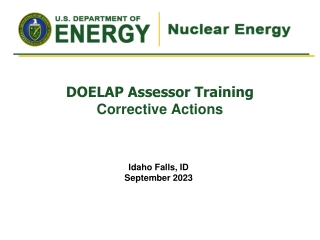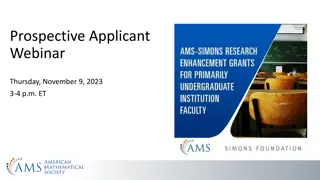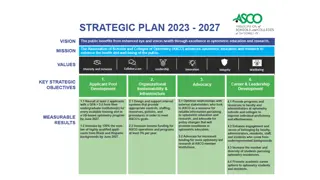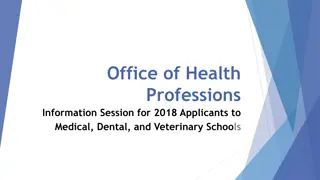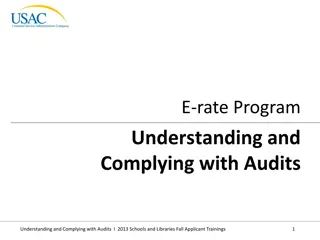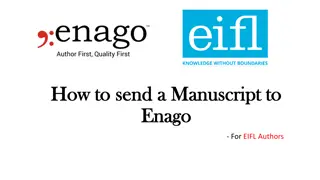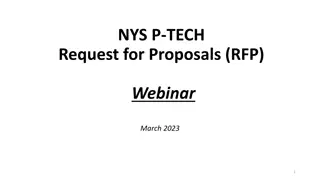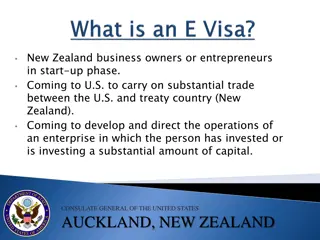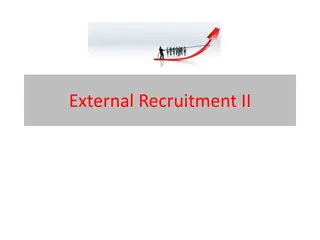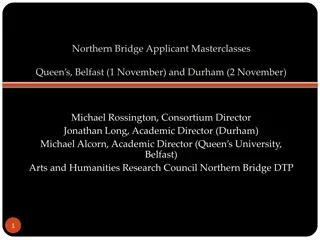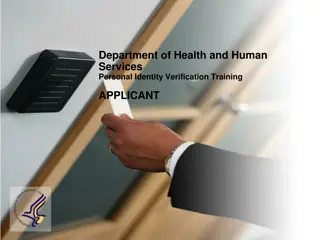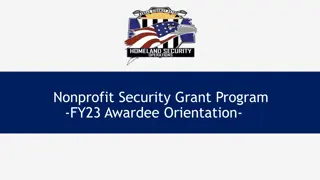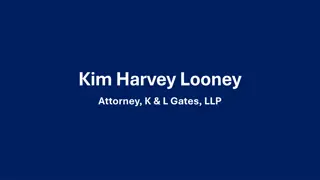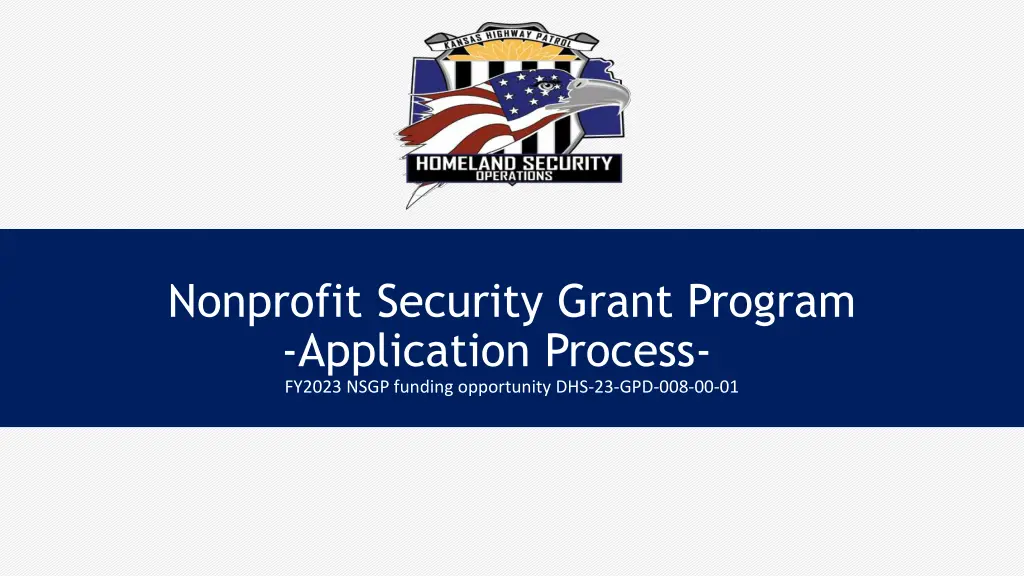
Kansas Nonprofit Security Grant Program Overview FY23
"Learn about the Kansas Nonprofit Security Grant Program for FY23, including eligibility criteria, required documents for application, submission deadlines, and program objectives. Find out how nonprofit organizations at risk of terrorist attacks can receive funding for security enhancements through this program."
Download Presentation

Please find below an Image/Link to download the presentation.
The content on the website is provided AS IS for your information and personal use only. It may not be sold, licensed, or shared on other websites without obtaining consent from the author. If you encounter any issues during the download, it is possible that the publisher has removed the file from their server.
You are allowed to download the files provided on this website for personal or commercial use, subject to the condition that they are used lawfully. All files are the property of their respective owners.
The content on the website is provided AS IS for your information and personal use only. It may not be sold, licensed, or shared on other websites without obtaining consent from the author.
E N D
Presentation Transcript
Nonprofit Security Grant Program -Application Process- FY2023 NSGP funding opportunity DHS-23-GPD-008-00-01
Preview of the State of Kansas Nonprofit Security Grant Program Overview Risk Assessment Eligibility Funding & Guidelines Objectives & Priorities Allowable Activities & Costs Unallowable Activities & Costs Application Packet Application lessons learned
Application Packet- What is Required 1. Obtain a Unique Entity Identifier (UEI). Must be obtained before submitting your application packet. 2. Nonprofit. Eligible nonprofit organizations are those organizations described under section 501(c)(3) of the Internal Revenue Code (IRC). a. Exemption Requirements 501(c)(3) Organizations b. Publication 557 (01/2022), Tax-Exempt Status for Your Organization c. Charities and Nonprofits 3. Complete the Following Documents: a. NSGP Investment Justification (IJ) This form can be found at www.datacounts.net/nsgp b. Vulnerability/Risk Assessment If you cannot schedule an on-site risk assessment, you can utilize a self risk assessment, or contact us directly for assistance. c. Mission Statement If you do not have a mission statement, you will need to create one.
Application due for S-NSGP The FY23 State Nonprofit Security Grant Program (S-NSGP) application packets must be submitted directly to NSGP.KHP@KS.GOV and carbon copy csatzler@kansas.net no later than 5:00 PM, April 7, 2023. Submissions after the deadline will not be considered. Applicants for the FY23 UA Nonprofit Security Grant Program Nonprofit -Kansas City Urban Area (Leavenworth, Wyandotte, and Johnson) counties can apply at https://dps.mo.gov/dir/programs/ohs/grantstraining/ under Grant Applications and Forms after their release date tentatively March 10, 2023. Interested applicants located in the Urban Area can contact Chelsey Call Chelsey.Call@dps.mo.gov or Debbie Musselman Debbie.musselman@dps.mo.gov or 573-751-5997 for more information. Missouri should be posting their application process 03/10/2023.
Nonprofit Security Grant Program (NSGP) Overview The Nonprofit Security Grant Program (NSGP) is funded through the U.S. Department of Homeland Security (DHS) / Federal Emergency Management Agency (FEMA) and is administered by the Kansas Highway Patrol (KHP). The State of Kansas designated State Administrative Agency (SAA) is the Kansas Highway Patrol (KHP). The entity within the KHP responsible for pass-through and oversight of the NSGP is the Homeland Security Operations Section (HSO). The Kansas Adjutant General, Director of Emergency Management is the appointed Authorized Representative (AR) responsible to sign grant applications and award acceptance documents for the DHS/FEMA grant programs to the State of Kansas. Non-Profit Security Grant Program (NSGP) - provides funding support for physical security enhancements and other security activities to nonprofit organizations that are at substantial risk of a terrorist attack.
NSGP Funding The total amount of funds under this grant program Nationwide is $90 million, of which $50 million is for NSGP-Urban Area (UA) and $40 million is for NSGP- State (S). For NSGP-S, applicants can apply for up to $150,000.00 per applicant (per facility with individual address) for a maximum of three facilities. Please do not simply apply for the maximum amount just because . All funding needs must be justified, and you must be able to complete all activities within a designated performance period set by the KS SAA as September 1, 2023, to May 31, 2026. Ultimately, FEMA/DHS can award up to $150,000.00 per applicant. You can list out and justify a need for more funding in the narrative portion of your IJ, but your funding request cannot exceed the KS cap of $150,000.00. The listed expenses in the 2ndportion of the Target Hardening (where AEL # s are listed must equal the requested amount)
NSGP Funding Guidelines NSGP allowable costs are focused on security-related activities. Funding can be used for; contracted security personnel security-related planning security-related exercises security-related training and the acquisition and installation of security equipment on real property (including buildings and improvements) owned or leased by the nonprofit organization at the time of application. Note: funds are not for cosmetic improvements, they must be specific to security enhancements. FEMA closely scrutinized project descriptions and will place financial holds where it is not clear. Landscaping is not an allowable cost- even if you believe it increases security- talk to the SAA for clarification. Funding is not meant for long term dependency and meant to increase self-reliance. Nonprofits should plan for future self-sustainment.
FY23 NSGP The List of allowable equipment and activities items on the Authorized Equipment List (AEL): 03OE-03-MEGA System, Public Address, Handheld or Mobile 04AP-09-ALRT Systems, Public Notification and Warning 05AU-00-TOKN System, Remote Authentication 05HS-00-MALW Software, Malware/Anti-Virus Protection 05NP-00-FWAL Firewall, Network Detection/Prevention 06CP-01-PORT Radio, Portable 06CP-03-ICOM Intercom 10GE-00-GENR Generators 14CI-00-COOP System, Information Technology Contingency Operations 14EX-00-BSIR Systems, Building, Blast/Shock/Impact Resistant 14SW-01-DOOR Doors and Gates, Impact Resistant 14SW-01-PACS System, Physical Access Control 14SW-01-SIDV Systems, Vehicle Identification Infrastructure Monitoring, Standalone Security 14SW-01-WALL Barriers: Fences; Jersey Walls Screening 21GN-00-INST Installation 04AP-05-CRED System, Credentialing 04AP-11-SAAS Applications, Software as a Service 05EN-00-ECRP Software, Encryption 05HS-00-PFWL System, Personal Firewall 05NP-00-IDPS System, Intrusion 06CC-02-PAGE Services/Systems, Paging 06CP-03-PRAC Accessories, Portable Radio 13IT-00-ALRT System, Alert/Notification 14EX-00-BCAN Receptacles, Trash, Blast-Resistant 14SW-01-ALRM Systems/Sensors, Alarm 14SW-01-LITE Lighting, Area, Fixed 14SW-01-SIDP Systems, Personnel Identification 14SW-01-SNSR Sensors/Alarms, System and 14SW-01-VIDA Systems, Video Assessment, 15SC-00-PPSS Systems, Personnel/Package 21GN-00-TRNG Training and Awareness You can look up the definitions of the listed AEL s at https://www.fema.gov/grants/tools/authorized-equipment-list .
NSGP Objectives Build and sustain core capabilities Strengthen governance integration between private nonprofit entities and Federal, state, and local governments Encourage a whole community approach to security and emergency management Support for physical security enhancements and other security activities to nonprofit organizations that are at high risk of a terrorist attack.
NSGP Priorities Given the evolving threat landscape, it is incumbent upon DHS/FEMA to continuously evaluate the national risk profile and set priorities that help ensure appropriate allocation of scarce security dollars. In assessing the national risk profile for FY 2022, one area attracts the most concern: Enhancing the protection of soft targets/crowded places; Likewise, there are several enduring security needs that crosscut the homeland security enterprise. The following are second-tier priorities that help recipients implement a comprehensive approach to securing communities: Effective planning; Training and awareness campaigns; and Exercises.
Priority Examples Priority Area Example Project Type Private security guards Physical security enhancements Security cameras (CCTV) Security screening equipment for people and baggage Access controls: Fencing, gates, barriers, etc. Enhancing the Protection of Soft Targets/Crowded Places Conduct or enhancement of security risk assessments Development of: Security plans and protocols Emergency contingency plans Evacuation/shelter in place plans Planning Active shooter training Security training for employees Public awareness/preparedness campaigns Training & Awareness Exercises Response exercises
Proposed Activities are limited to: 1. Planning Costs: Security or emergency planning expenses and the materials utilized to conduct planning activities. Planning must be related to the protection of the facility and the people within the facility and should include people with access and functional needs as well as those with limited English proficiency. 2. Exercise Costs: Conduct security-related exercises. This includes costs related to planning, meeting space and other meeting costs, facilitation costs, materials and supplies, and documentation. See the FEMA Preparedness Grants Manual for more information. 3. Training Costs: Costs for training of security personnel are permitted. Allowable training topics are limited to the protection of critical infrastructure and key resources, including physical and cybersecurity, target hardening, and terrorism awareness/employee preparedness. Training conducted using NU-NSGP funds must address a specific threat and/or vulnerability, as identified in the nonprofit organization s investment justification (IJ). See the FEMA Preparedness Grants Manual for more information. 4. Equipment: Authorized Equipment List (AEL) Physical Security Enhancement Equipment (Category 14) and Inspection and Screening Systems (Category 15). For more information regarding property management standards for equipment, please reference 2 C.F.R. 200.313, located on the Electronic Code of Federal Regulations. 5. Maintenance and Sustainment Costs: Maintenance, contracts, warranties, repair or replacement costs, upgrades, and user fees as described in FP 205-402-125-1 Maintenance Contracts and Warranty Coverage Funded by Preparedness Grants. 5. Maintenance and Sustainment Costs: Maintenance, contracts, warranties, repair or replacement costs, upgrades, and user fees as described in FP 205-402-125-1 Maintenance Contracts and Warranty Coverage Funded by Preparedness Grants.
Allowable Costs Management and Administration (M&A) M&A activities are those costs defined as directly relating to the management and administration of NSGP funds, such as financial management and monitoring. The amount of M&A is specified in each fiscal year s NSGP NOFO. M&A costs include the following categories of activities: Hiring of full-time or part-time staff or contractors/consultants responsible for activities relating to the management and administration of NSGP funds. Meeting-related expenses directly related to M&A of NSGP funds Indirect (Facilities and Administrative [F&A]) Costs. Note: These must be listed in the IJ and Pre-Approved Indirect costs are allowable under this program as described in 2 C.F.R. Part 200, including 2 C.F.R. 200.414. Applicants with a negotiated indirect cost rate agreement that desire to charge indirect costs to an award must provide a copy of their negotiated indirect cost rate agreement at the time of application. Applicants that are not required by 2 C.F.R. Part 200 to have a negotiated indirect cost rate agreement but are required by 2 C.F.R. Part 200 to develop an indirect cost rate proposal must provide a copy of their proposal at the time of application. Post-award requests to charge indirect costs will be considered on a case-by-case basis and based upon the submission of an agreement or proposal.
Allowable Direct Costs- Planning Funding may be used for security or emergency planning expenses and the materials required to conduct planning activities. Planning must be related to the protection of the facility and the people within the facility and should include consideration of access and functional needs as well as those with limited English proficiency. Examples of planning activities allowable under this program include: Development and enhancement of security plans and protocols Development or further strengthening of security assessments Emergency contingency plans Evacuation/Shelter-in-place plans Other project planning activities with prior approval from DHS/FEMA
Allowable Direct Costs- Equipment Allowable costs are focused on target hardening and physical security enhancements. Funding can be used for the acquisition and installation of security equipment on real property (including buildings and improvements) owned or leased by the nonprofit organization, specifically in prevention of and/or protection against the risk of a terrorist attack. This equipment is limited to select items in the following two sections of items on the Authorized Equipment List (AEL): Physical Security Enhancement Equipment (Section 14) Inspection and Screening Systems (Section 15) Portable radios public warning & notification The two allowable prevention and protection categories and equipment standards for the NSGP are listed on DHS AEL located on the DHS/FEMA site at http://www.fema.gov/authorized-equipment-list . Unless otherwise stated, equipment must meet all mandatory statutory, regulatory, and DHS/FEMA-adopted standards to be eligible for purchase using these funds, including the Americans with Disabilities Act. In addition, recipients will be responsible for obtaining and maintaining all necessary certifications and licenses for the requested equipment. Applicants should analyze the cost benefits of purchasing versus leasing equipment, especially high-cost items and those subject to rapid technical advances. Large equipment purchases must be identified and explained. For more information regarding property management standards for equipment, please reference 2 C.F.R. Part 200, including but not limited to 2 C.F.R. 200.310, 200.313, and 200.316.
Allowable Direct Costs- Exercises Funding may be used to conduct security-related exercises. This includes costs related to planning, meeting space and other meeting costs, facilitation costs, materials and supplies, and documentation. Exercises afford organizations the opportunity to validate plans and procedures, evaluate capabilities, and assess progress toward meeting capability targets in a controlled, low-risk setting. All shortcomings or gaps including those identified for children and individuals with access and functional needs should be identified in an improvement plan. Improvement plans should be dynamic documents with corrective actions continually monitored and implemented as part of improving preparedness through the exercise cycle. The Homeland Security Exercise and Evaluation Program (HSEEP) provides a set of guiding principles for exercise programs, as well as a common approach to exercise program management, design and development, conduct, evaluation, and improvement planning. For additional information on HSEEP, NSGP Appendix | February 2020 Page C-3 refer to https://www.fema.gov/exercise .
Allowable Direct Costs- Maintenance and Sustainment The use of DHS/FEMA preparedness grant funds are allowable for; maintenance contracts, warranties, repair or replacement costs, upgrades, and Maintenance Contracts and Warranty Coverage Funded by Preparedness Grants, located at http://www.fema.gov/media-library/assets/documents/32474 , under all active and future grant awards, unless otherwise noted. Grant funds are intended to support the National Preparedness Goal and fund projects that build and sustain the core capabilities necessary to prevent, protect against, mitigate the effects of, respond to, and recover from those threats that pose the greatest risk to the security of the Nation. Eligible maintenance and sustainment costs must be; (1) In direct support of existing capabilities, (2) must be an otherwise allowable expenditure under the applicable grant program, and (3) be tied to one of the core capabilities in the five mission areas outlined in the Goal. Additionally, eligible costs may also support equipment, training, and critical resources that have previously been purchased with either federal grant or any other source of funding other than DHS/FEMA preparedness grant program dollars.
Allowable Direct Costs- Construction and Renovation NSGP funding may not be used for construction and renovation projects without prior written approval from DHS/FEMA. All recipients of NSGP funds must request and receive prior approval from DHS/FEMA before any NSGP funds are used for any construction or renovation. Additionally, recipients are required to submit a SF-424C Budget and budget detail citing the project costs. The total cost of any construction or renovation paid for using NSGP funds may not exceed the greater amount of $100,000.00 or 15% of the NSGP award. Recipients and subrecipients are also encouraged to have completed as many steps as possible for a successful EHP review in support of their proposal for funding (e.g., coordination with their State Historic Preservation Office to identify potential historic preservation issues and to discuss the potential for project effects, compliance with all State and EHP laws and requirements). Projects for which the recipient believes an Environmental Assessment (EA) may be needed, as defined in DHS Instruction Manual 023-01-001-01, Revision 01, FEMA Directive 108-1, and FEMA Instruction 108-1-1, must also be identified to the FEMA HQ Program Analyst within six months of the award and completed EHP review materials must be submitted no later than 12 months before the end of the period of performance. EHP review packets should be sent to NSGP.KHP@KS.GOV, so your EHP can be submitted to FEMA on your behalf. Note: Compliance requirements
Allowable Direct Costs- Training Nonprofit organizations may use NSGP funds for the following training-related costs: Employed or volunteer security staff to attend security-related training within the United States; Employed or volunteer staff to attend security-related training within the United States with the intent of training other employees or members/congregants upon completing the training (i.e., train-the-trainer type courses) Nonprofit organization s employees, or members/congregants to receive on-site security training. Allowable training-related costs under the NSGP are limited to attendance fees for training and related expenses, such as materials, supplies, and/or equipment. Overtime, backfill, and travel expenses are not allowable costs. Allowable training topics are limited to the protection of critical infrastructure key resources, including physical and cybersecurity, target hardening, and terrorism awareness/employee preparedness such as Community Emergency Response Team (CERT) training, Active Shooter training, and emergency first aid training. Training conducted using NSGP funds must address a specific threat and/or vulnerability, as identified in the nonprofit organization s IJ. Training should provide the opportunity to demonstrate and validate skills learned as well as to identify any gaps in these skills. Proposed attendance at training courses and all associated costs using the NSGP must be included in the nonprofit organization s IJ.
Allowable Direct Costs- Contracted Security Personnel Contracted security personnel are allowed under this program only as described in the NOFO and Manual and comply with guidance set forth in IB 421b and IB 441. NSGP funds may not be used to purchase equipment for contracted security. The recipient must be able to sustain this capability in future years without NSGP funding. Important: If you are planning to utilize more than 50% of your award towards personnel costs, an additional step of requesting a waiver through FEMA is required. Note: Nonprofits should not plan for long-term sustainment and plan to absorb future costs.
Unallowable Costs The following projects and costs are considered ineligible for award consideration: Organization costs, and operational overtime costs Hiring of public safety personnel General-use expenditures Overtime and backfill Initiatives that do not address the implementation of programs/initiatives to build prevention and protection-focused capabilities directed at identified facilities and/or the surrounding communities The development of risk/vulnerability assessment models Initiatives that fund risk or vulnerability security assessments or the development of the IJ Initiatives in which federal agencies are the beneficiary or that enhance federal property Initiatives which study technology development Proof-of-concept initiatives Initiatives that duplicate capabilities being provided by the Federal Government Organizational operating expenses Reimbursement of pre-award security expenses
Application Packet- What is Required 1. Obtain a Unique Entity Identifier (UEI). Must be obtained before submitting your application packet. 2. Nonprofit. Eligible nonprofit organizations are those organizations described under section 501(c)(3) of the Internal Revenue Code (IRC). a. Exemption Requirements 501(c)(3) Organizations b. Publication 557 (01/2022), Tax-Exempt Status for Your Organization c. Charities and Nonprofits 3. Complete the Following Documents: a. NSGP Investment Justification (IJ) This form can be found at www.datacounts.net/nsgp b. Vulnerability/Risk Assessment If you cannot schedule an on-site risk assessment, you can utilize a self risk assessment, or contact us directly for assistance. c. Mission Statement If you do not have a mission statement, you will need to create one. Email your completed Packets to NSGP.KHP@KS.GOV and carbon copy csatzler@kansas.net .
Application Packet- Continued d. Other Supporting Information (if necessary) Environmental Planning and Historic Preservation (EHP). EHP is not required at time of application but required before any physical work can begin on your facility. Other supporting documents may include; Police Reports/ articles / logs of activity that supports your need for security enhancements Security team / working group / council meeting minutes or other record supporting
Application Packet- Scoring Matrix Use the provided scoring resources to maximize your chances of funding. Answer all questions on the Investment Justification (IJ) completely and correctly. Self-evaluate your own application with the Scoring Matrix. Include an Environmental Planning and Historical Preservation (EHP) review milestone on your IJ. Make sure you correctly identify your organization type. If your focus appropriately fits in multiple categories, choose the one with the highest multiplier (pg 33 of the NOFO). Check your County and/or Census Tract Social Vulnerability Index (SVI). If your SVI is above 0.60, include a note in Part III (A) of your IJ to make sure you receive credit for extra points (pg 33 of the NOFO).
Application lessons learned Review the scoring matrix to give you an edge https://www.datacounts.net/nsgp/documents/FY22/FY22%20NSGP%20Scoring%20Mat rix_FINAL.pdf Read the directions on the IJ completely Fill in each section Do not copy and paste duplicate projects make sure each facility stands out from each other Double check your math equals the requested amount Only list allowable items Make sure milestones are reasonable and list key actions that receive a score, such as Environment Historic Preservation (EHP) approval . Detail your facility vulnerabilities and Priorities (Target Hardening) Review before submitting your packet If you have questions, go to http://www.datacounts.net/nsgp or reach out and ask NSGP.KHP@KS.GOV
RESOURCES Nonprofit Security Grant Program resources website http://datacounts.net/nsgp FEMA-NSGP Guidance https://www.fema.gov/grants/preparedness/nonprofit-security Preparedness Grants Manual https://www.fema.gov/grants/preparedness Kansas Procurement https://www.admin.ks.gov/offices/procurement-and-contracts Code of Federal Regulations https://www.ecfr.gov/cgi-bin/ECFR?page=browse Kansas Homeland Security Preparedness Grant Programs Policy Manual http://datcounts.net/nsgp

